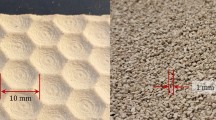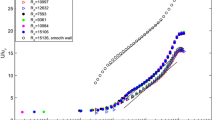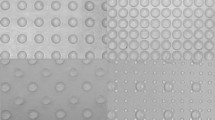Abstract
Stanton numbers, mean temperature profiles, and turbulent heat flux profiles are presented for thermal boundary layers which develop over a uniformly rough surface downstream of steps in wall temperature. Artificially thickened hydrodynamic layers were employed in order to create large unheated starting lengths compared to boundary-layer thickness, where the unheated starting length is the distance between the temperature step and hydrodynamic boundary-layer origin. Kernel functions for Stanton number distributions with downstream distance are presented which agree with measurements even when the hydrodynamic layers are significantly thicker than thermal layers. Other effects of unheated starting lengths on rough-wall thermal boundary-layer behavior are described, including significant alterations in profiles of mean temperature and turbulent heat flux. Both change shape as the magnitude of the unheated starting length increases, even though logarithmic regions of temperature profiles in wall coordinates and turbulent Prandtl number distributions are largely unaffected by unheated starting-length effects.
Similar content being viewed by others
References
Antonia, R. A., Danh, H. Q., and Prabhu, A.: 1977, ‘Response of a Turbulent Boundary Layer to a Step Change in Surface Heat Flux’, J. Fluid Mech. 80, 153–177.
Blom, J. : 1970, ‘Experimental Determination of the Turbulent Prandtl Number in a Developing Temperature Boundary Layer’, Fourth International Heat Transfer Conference, Paris-Versailles, Volume II, Forced Convection, Paper FC 2.2.
Coleman, H. W., Moffat, R. J., and Kays, W. M.: 1976a, ‘Momentum and Energy Transport in the Accelerated Fully Rough Turbulent Boundary Layer’, Report No. HMT-24, Thermosciences Division, Dept. of Mechanical Engineering, Stanford University.
Coleman, H. W., Pimenta, M. M., and Moffat, R. J.: 1976b, ‘Rough Wall Turbulent Heat Transfer with Variable Velocity, Wall Temperature and Blowing’, AIAA Paper No. 76-146, AIAA 14th Aerospace Sciences Meeting, Washington, D.C., January 26–28.
Coles, D.: 1956, ‘The Law of the Wake in the Turbulent Boundary Layer’, J. Fluid Mech. 1, 191–226.
Ede, A. J. and Saunders, O. A.: 1958, ‘Heat Transfer from a Flat Surface to a Parallel Stream of Water’, Proceedings of the Institution of Mechanical Engineers, Vol. 172, p. 743.
Ferrari, C.: 1954, ‘Determination of the Heat Transfer Properties of a Turbulent Boundary Layer in the Case of Supersonic flow when the Temperature Distribution along the Constraining Wall is Arbitrarily Assigned’, Report No. CAL-CM/807, Cornell Aeronautical Laboratory, Inc.
Hartnett, J. P., Eckert, E. R. G., Birkebak, R., and Sampson, R. L.: 1956, ‘Simplified Procedures for the Calculation of Heat Transfer to Surfaces with Non-Uniform Temperatures’, WADC Technical Report 56-373.
Johnson, D. S.: 1957, ‘Velocity, Temperature, and Heat-Transfer Measurements in a Turbulent Boundary Layer Downstream of a Stepwise Discontinuity in Wall Temperature’, ASME Transactions — J. Appl. Mech. 24, 2–8.
Johnson, D. S.: 1959, ‘Velocity and Temperature Fluctuation Measurements in a Turbulent Boundary Layer Downstream of a Stepwise Discontinuity in Wall Temperature’, ASME Transactions — J. Appl. Mech. 26, 325–336.
Kays, W. M. and Crawford, M. E.: 1980, Convective Heat and Mass Transfer, Second Edition, McGraw-Hill Book Co., New York.
Ligrani, P. M. and Moffat, R. J.: 1979a, ‘Artificially Thickening a Smooth-Wall Turbulent Boundary Layer’, AIAA Journal 17, 907–910.
Ligrani, P. M., Moffat, R. J., and Kays, W. M.: 1979b, ‘The Thermal and Hydrodynamic Behavior of Thick, Rough-Wall, Turbulent Boundary Layers’, Report HMT-29, Thermosciences Division, Dept. of Mechanical Engineering, Stanford University.
Ligrani, P. M., Kays, W. M., and Moffat, R. J.: 1981, ‘A Heat Transfer Prediction Method for Turbulent Boundary Layers Developing over Rough Surfaces with Transpiration’, Int. J. Heat and Mass Transfer 24, 774–778.
Ligrani, P. M., Moffat, R. J., and Kays, W. M.: 1983, ‘Artificially Thickened Turbulent Boundary Layers for Studying Heat Transfer and Skin Friction on Rough Surfaces’, ASME Transactions - J.Fluids Eng. 105, 146–153.
Monin, A. S. and Yaglom, A. M.: 1971, Statistical Fluid Mech. 1, The MIT Press.
Pimenta, M. M., Moffat, R. J., and Kays, W. M.: 1975, ‘The Turbulent Boundary Layer: An Experimental Study of the Transport of Momentum and Heat with the Effect of Roughness’, Report HMT-21, Thermosciences Division, Dept. of Mechanical Engineering, Stanford University.
Reynolds, W. C., Kays, W. M., and Kline, S. J.: 1958a, ‘Heat Transfer in the Turbulent Incompressible Boundary Layer. I - Constant Wall Temperature’, NASA Memo 12-1-58 W, Washington.
Reynolds, W. C., Kays, W. M., and Kline, S. J.: 1958b, ‘atHeat Transfer in the Turbulent Incompressible Boundary Layer, II - Step Wall Temperature Distribution’, NASA Memo 12-2-58 W, Washington.
Reynolds, W. C., Kays, W. M., and Kline, S. J.: 1958c, ‘Heat Transfer in the Turbulent Incompressible Boundary Layer. III - Arbitrary Wall Temperature and Heat Flux’, NASA Memo 12-3-58 W, Washington.
Rubesin, M. W.: 1951, ‘The Effect of an Arbitrary Surface-Temperature Variation along a Flat Plate on the Convective Heat Transfer in an Incompressible Turbulent Boundary Layer’, NACA TN 2345.
Scesa, S. and Sauer, F. M.: 1952, ‘An Experimental Investigation of Convective Heat Transfer to Air from a Flat Plate with a Stepwise Discontinuous Surface Temperature’, Trans. ASME 74, 1251–1255.
Schlichting, H.: 1968, Boundary Layer Theory, Sixth Edition, McGraw-Hill Book Co.
Sogin, H. H. and Goldstein, R. J.: 1961, ‘Turbulent Transfer from Isothermal Spanwise Strips on a Flat Plate’, International Developments in Heat Treatsfer, ASME/Inst. of Mech. Engrs., Part II, Section B, Paper No. 55, pp. 447–453.
Scesa, S. and Sauer, F. M.: 1952, ‘An Experimental Investigation of Convective Heat Transfer to Air from a Flat Plate with a Stepwise Discontinuous Surface Temperature’, Trans. ASME 74, 1251–1255.
Schlichting, H.: 1968, Boundary Layer Theory, Sixth Edition, McGraw-Hill Book Co.
Sogin, H. H. and Goldstein, R. J.: 1961, ‘Turbulent Transfer from Isothermal Spanwise Strips on a Flat Plate’, International Developments in Heat Transfer, ASME/Inst. of Mech. Engrs., Part II, pp. 447–453.
Spalding, D. B.: 1961, ‘Heat Transfer to a Turbulent Stream from a Surface with Spanwise Discontinuity in Wall Temperature’, International Developments in Heat Transfer, ASME/Inst. of Mech. Engrs., Part II, p. 439.
Townsend, A. A.: 1965, ‘Self-Preserving Flow Inside a Turbulent Boundary Layer’, J. Fluid Mech. 22, 773–797.
Author information
Authors and Affiliations
Rights and permissions
About this article
Cite this article
Ligrani, P.M., Moffat, R.J. Thermal boundary layers on a rough surface downstream of steps in wall temperature. Boundary-Layer Meteorol 31, 127–147 (1985). https://doi.org/10.1007/BF00121174
Revised:
Issue Date:
DOI: https://doi.org/10.1007/BF00121174




